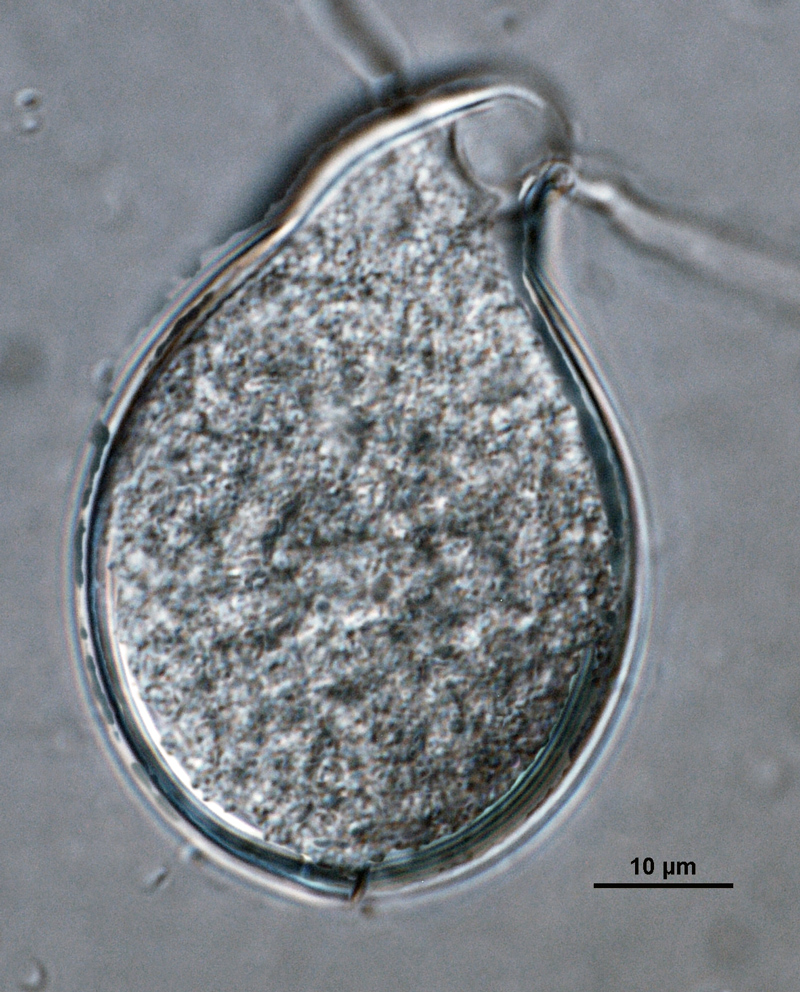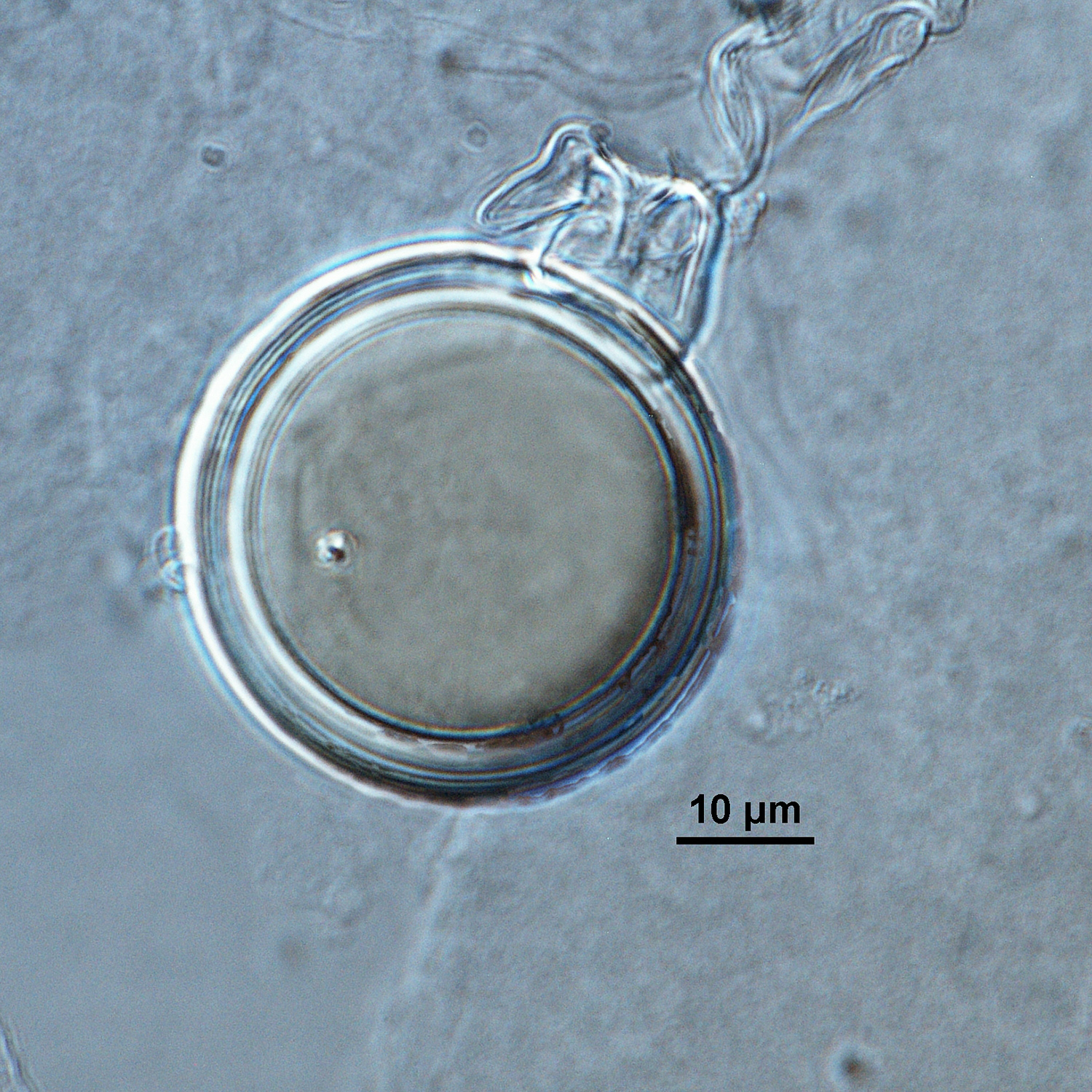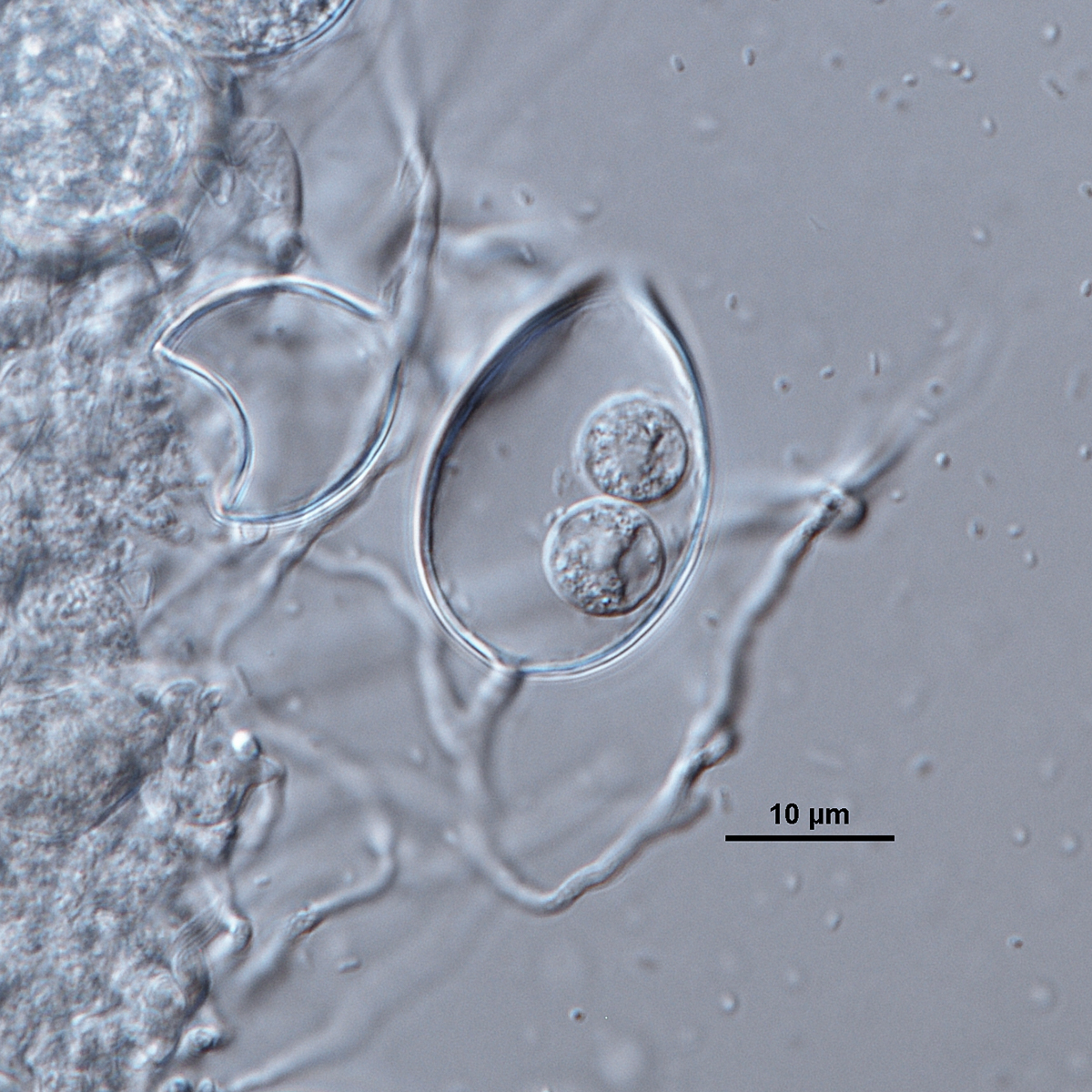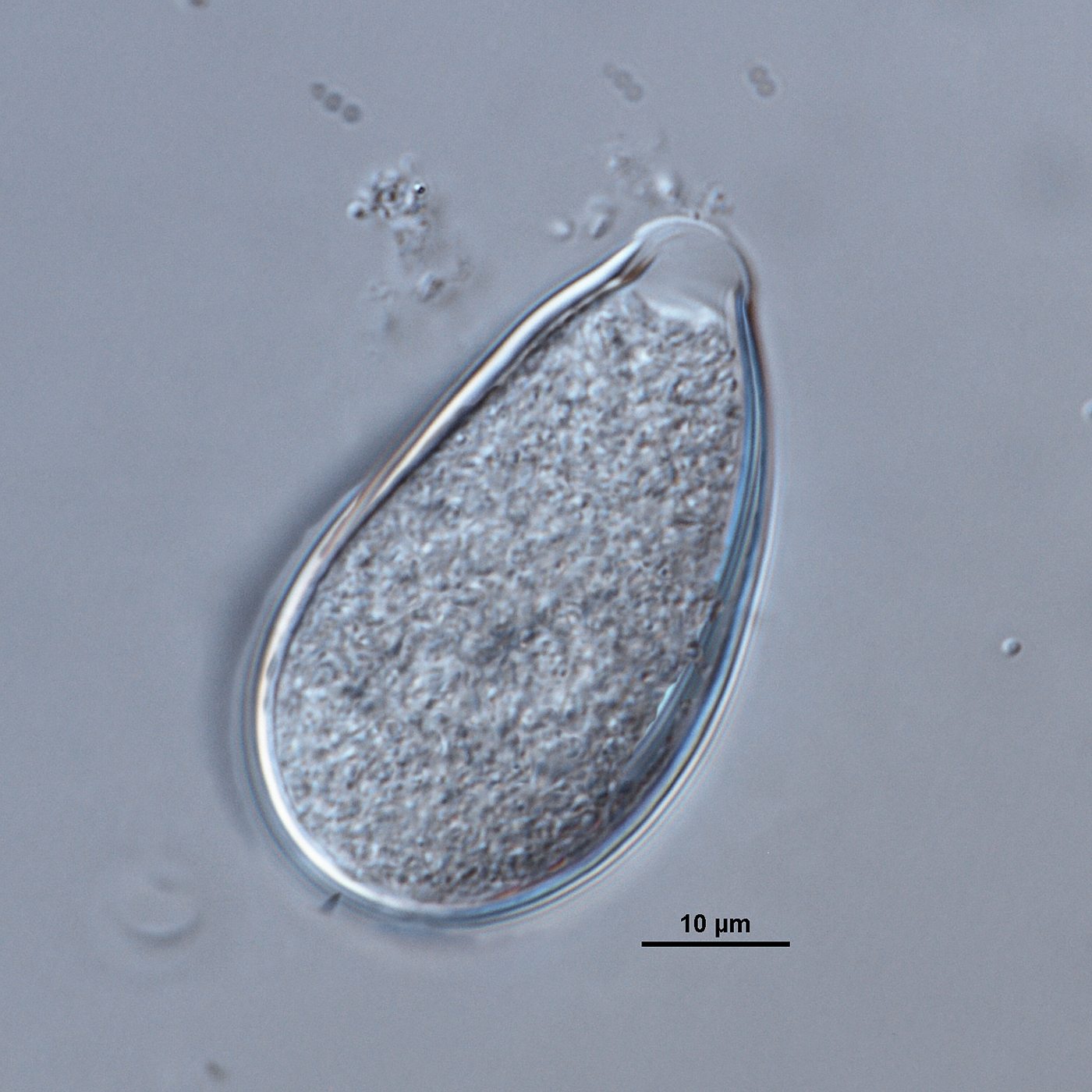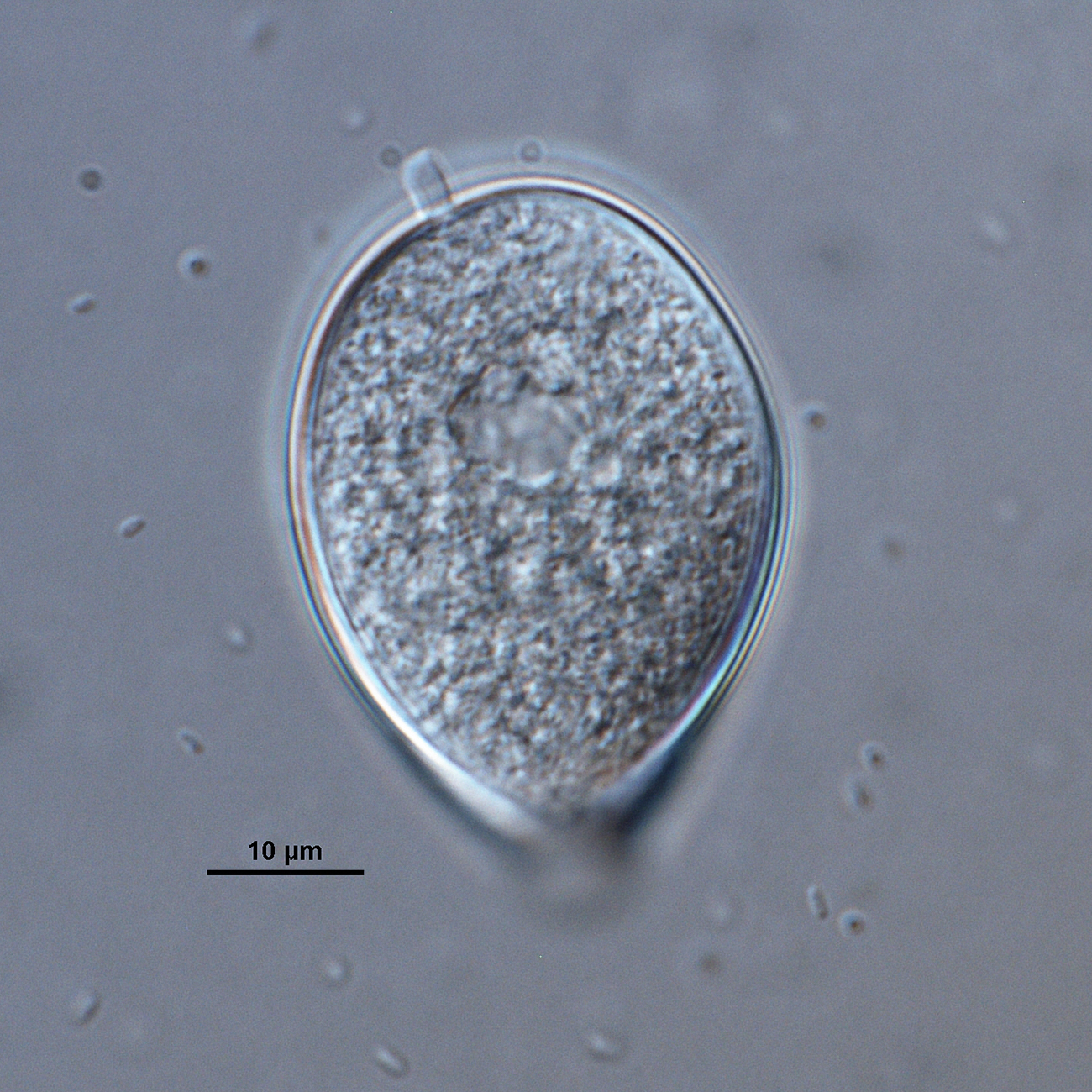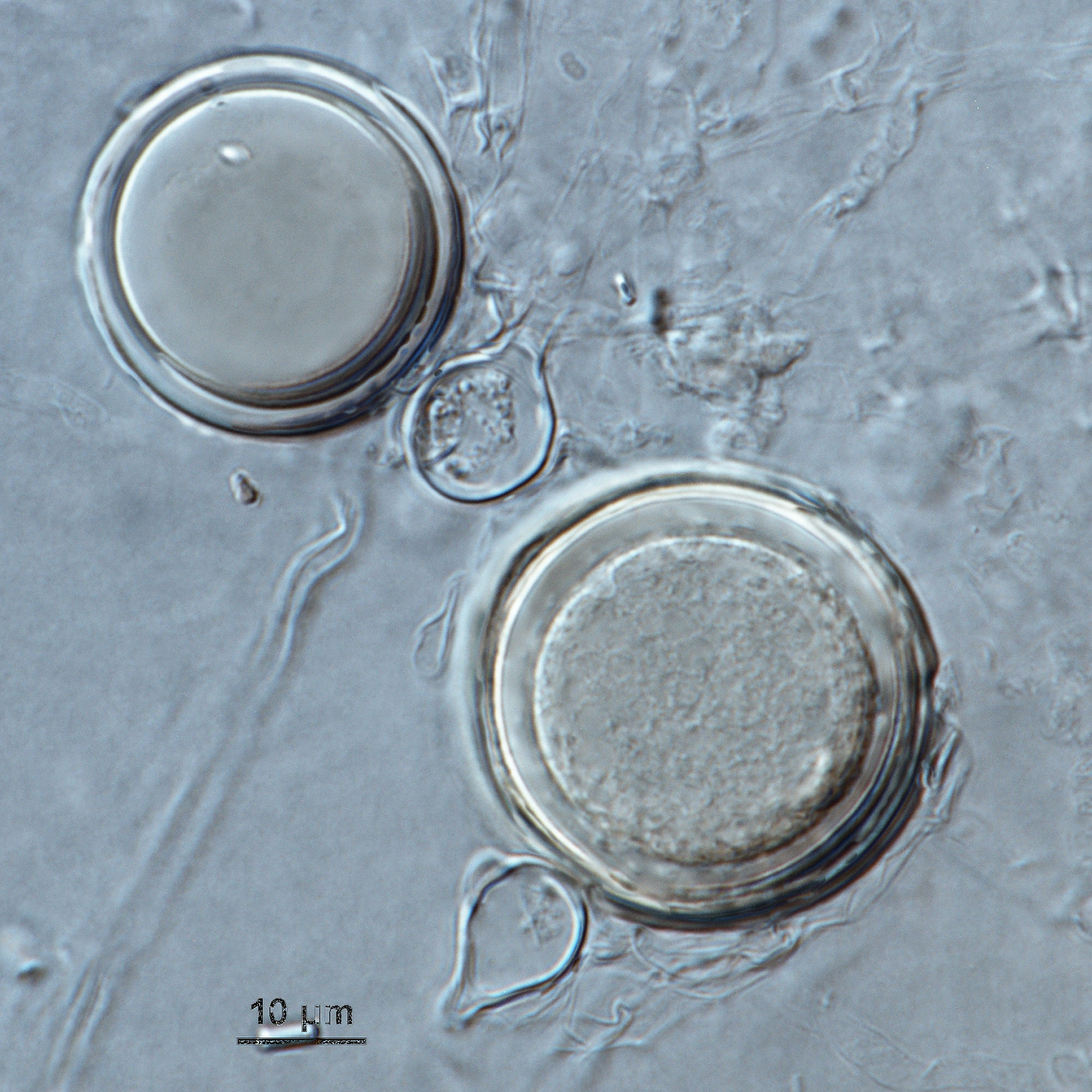Phytophthora tentaculata
|
Phytophthora spp. in subclade 1b: portion of the seven-loci ML phylogeny featuring the type cultures of 212 described species (by T. Bourret). Notice the position of P. tentaculata Ex-type CBS 412.96 = S&T BL 29. Gloria Abad, USDA S&T.
|
|
Phytophthora spp. in subclade 1b: Morphological Tabular key (PDF) and Tabular key legends (PDF) in IDphy2 KEY SECTION. Notice the data of P. tentaculata a Ex-type CBS 412.9 = S&T BL 29. Gloria Abad, USDA S&T.
|
|
Phytophthora tentaculata (ex-type CPHST BL 29) asexual phase (a–g): (a–d) shapes of sporangia, (a–c) papillated caducous with short pedicels, (d) with 2 zoospores; (e, f) hyphal swellings; (g) terminal chlamydospore; photos by G. Abad, USDA-APHIS-PPQ. |
|
Phytophthora tentaculata (ex-type CPHST BL 29) sexual phase (a–d): (a, b) oogonia with paragynous antheridia, (c, d) oogonia with amphigynous antheridia and plerotic oospores; photos by G. Abad, USDA-APHIS-PPQ. |
|
Phytophthora tentaculata selected specimen P8497 sexual phase, oogonium with aplerotic oospore and amphigynous antheridium; photo by G. Abad, USDA-APHIS-PPQ. |
|
Phytophthora tentaculata selected specimen P8497 sexual phase, oogonium with semiplerotic oospore and two paragynous antheridia; photo by G. Abad, USDA-APHIS-PPQ. |
|
Phytophthora tentaculata (ex-type CPHST BL 29): hyphal swellings; photo by G. Abad, USDA-APHIS-PPQ. |
|
Phytophthora tentaculata (ex-type CPHST BL 29): hyphal swellings; photo by G. Abad, USDA-APHIS-PPQ. |
|
Phytophthora tentaculata (ex-type CPHST BL 29) asexual phase: papillate caduceus sporangium with short pedicel; photo by G. Abad, USDA-APHIS-PPQ. |
|
Phytophthora tentaculata (ex-type CPHST BL 29) sexual phase: oogonium with amphigynous antheridium and plerotic oospore; photo by Gloria Abad, USDA-APHIS-PPQ. |
|
Phytophthora tentaculata (ex-type CPHST BL 29) asexual phase: sporangium with 2 zoospores; photo by G. Abad, USDA-APHIS-PPQ. |
|
Phytophthora tentaculata (ex-type CPHST BL 29) sexual phase: oogonia with paragynous antheridia; photo by Gloria Abad, USDA-APHIS-PPQ. |
|
Phytophthora tentaculata (ex-type CPHST BL 29) asexual phase: papillate caduceus sporangium with short pedicel; photo by G. Abad, USDA-APHIS-PPQ. |
|
Phytophthora tentaculata (ex-type CPHST BL 29) asexual phase: papillate caducous sporangium with short pedicel; photo by G. Abad, USDA-APHIS-PPQ. |
|
Phytophthora tentaculata (ex-type CPHST BL 29) sexual phase: oogonia with paragynous antheridia; photo by Gloria Abad, USDA-APHIS-PPQ. |
|
Phytophthora tentaculata (ex-type CPHST BL 29) asexual phase: terminal chlamydospore; photo by G. Abad, USDA-APHIS-PPQ. |
Name and publication
Phytophthora tentaculata Kröber & Marwitz (1993)
Kröber H and Marwitz R. 1993. Phytophthora tentaculata sp. nov. und Phytophthora cinnamomi var. parvispora var. nov. zwei neue Pilze von Deutschland. Z. Pflanzenk. Pflanzen. 100: 250–258.
Nomenclature
from Kröber and Marwitz (1993)
Mycobank
Etymology
tentaculatus = “tentacles elongated,” refers to the hyphahypha:
single, tubular filament of a fungal or oomycete thallus; the basic structural unit of a fungus or oomycete
of the diclinousdiclinous:
the hypha bearing the antheridium originated from a different hypha than that of the oogonium (cf. monoclinous)
antheridia
Typification
Type: GERMANY, from Chrysanthemum frutescens L. (Compositae), collected by R. Marwitz in Frankfurt/Main in 1990, BBA 65425 (Institut fur Mikrobiologie, Biologische Bundesanstalt für Land- und Forstwirtschaft, Berlin-Dahlem)
Ex-type: no code for the ex-type provided in the original manuscript
Ex-type in other collections
(ET) CBS 412.96, WPC P8496, S&T BL 29 (Abad)
Molecular identification
Voucher sequences for barcoding genes (ITS rDNA and COI) of the ex-type (see Molecular protocols page)
Phytophthora tentaculata isolate CPHST BL 29 (= P8496 WPC) = ITS rDNA MG865591, COI MH136983
Voucher sequences for Molecular Toolbox with seven genes (ITS, β-tub, COI, EF1α, HSP90, L10, and YPT1
(see Molecular protocols page) (In Progress)
Voucher sequences for Metabarcoding High-throughput Sequencing (HTS) Technologies [Molecular Operational Taxonomic Unit (MOTU)]
(see Molecular protocols page) (In Progress)
Sequences with multiple genes for ex-type in other sources
- NCBI: Phytophthora tentaculata CPHST BL 29
- NCBI: Phytophthora tentaculata P8496
- NCBI: Phytophthora tentaculata CBS 412.96
- Q-bank: Phytophthora tentaculata CBS 412.96
- BOLDSYSTEMS: Phytophthora tentaculata OOMYA2107 [COI-5P:624, ITS:792] = CBS 412.96 (barcoding COI & ITS)
Position in multigenic phylogeny with 7 genes (ITS, β-tub, COI, EF1α, HSP90, L10, and YPT1)
Clade clade:
a taxonomic group of organisms classified together on the basis of homologous features traced to a common ancestor
1b
Morphological identification
Colonies and cardinal temperatures
Colony colony:
assemblage of hyphae which usually develops form a single source and grows in a coordinated way
morphology on CMA, PDA, and V-8 agar with no distinctive pattern. The minimum temperature for growth is 6°C, optimum 20–25°C, and maximum 30°C.
Conditions for growth and sporulation
Oogonia form abundantly in culture.
Asexual phase
SporangiaSporangia:
sac within which zoospores form, especially when water is cooled to about 10°C below ambient temperature; in solid substrates, sporangia usually germinate by germ tubes
papillatepapillate:
pertaining to the production of a distinct papilla at the distal end of the sporangium (cf. nonpapillate and semipapillate)
, some bipapillate; caducouscaducous:
pertaining to sporangia that become dislodged readily (i.e. deciduous) and separate from the sporangiophore (cf. persistent)
with short pedicels; ovoidovoid:
egg-shaped, with the widest part at the base of the sporangium and the narrow part at the apex
, obpyriformobpyriform:
inversely pear-shaped, i.e. with the widest part at the point of attachment (cf. pyriform)
, or distorted shapes (25–60 µm length x 15–45 µm width) many with elongated necks; originated in unbranched or simple sympodial sporangiohores. Hyphal swellings are small, intercalaryintercalary:
positioned within a hypha (cf. terminal)
, and with radiating hyphaehyphae:
single, tubular filament of a fungal or oomycete thallus; the basic structural unit of a fungus or oomycete
. ChlamydosporesChlamydospores:
an asexual spore with a thickened inner wall that is delimited from the mycelium by a septum; may be terminal or intercalary, and survives for long periods in soil
spherical (20–45 µm diam.), intercalaryintercalary:
positioned within a hypha (cf. terminal)
or terminal.
Sexual phase
Homothallichomothallic:
pertaining to sexual reproduction that can take place within a single thallus (i.e. self-fertile, non-outcrossing) (cf. heterothallic).
. OogoniaOogonia:
the female gametangium in which the oospore forms after fertilization by the antheridium
smooth-walled, globoseglobose:
having a rounded form resembling that of a sphere
(20–49 µm diam.); antheridiaantheridia:
the male gametangium; a multinucleate, swollen hyphal tip affixed firmly to the wall of the female gametangium (the oogonium)
paragynousparagynous:
pertaining to the sexual stage in which the antheridium is attached to the side of the oogonium (cf. amphigynous)
, one to two, rarely three per oogoniumoogonium:
the female gametangium in which the oospore forms after fertilization by the antheridium
, spherical, ellipsoidellipsoid:
refers to a solid body that forms an ellipse in the longitudinal plane and a circle in cross section; many fungal spores are ellipsoidal or elliptic
, or irregular (20–35 µm), often attached distant from the oogonial stalk, diclinousdiclinous:
the hypha bearing the antheridium originated from a different hypha than that of the oogonium (cf. monoclinous)
antheridiaantheridia:
the male gametangium; a multinucleate, swollen hyphal tip affixed firmly to the wall of the female gametangium (the oogonium)
very common, amphigynousamphigynous:
pertaining to the sexual stage in which the antheridium completely surrounds the stalk of the oogonium (cf. paragynous)
antheridia occasionally produced; oosporesoospores:
zygote or thick-walled spore that forms within the oogonium after fertilization by the antheridium; may be long-lived
pleroticplerotic:
pertaining to an oospore that fills the oogonium (cf. aplerotic)
, apleroticaplerotic:
pertaining to a mature oospore that does not fill the oogonium; i.e. there is room left between the oospore wall and oogonium wall (cf. plerotic)
, or slightly apleroticaplerotic:
pertaining to a mature oospore that does not fill the oogonium; i.e. there is room left between the oospore wall and oogonium wall (cf. plerotic)
, spherical (14–38 µm diam.).
Most typical characters
Phytophthora tentaculata is characterized by the presence of hyphal swellings and by the shape of the caducouscaducous:
pertaining to sporangia that become dislodged readily (i.e. deciduous) and separate from the sporangiophore (cf. persistent)
sporangia.
Specimen(s) evaluated
Phytophthora tentaculata ex-type CPHST BL 29, duplicate of P8496 (World Phytophthora Collection)
Hosts and distribution
Distribution: Asia (China), Europe (Italy, Spain, Germany), North America (USA: CA)
Substrate: roots, stems
Disease note: root rot, stem rot. Heavily infected plants are killed (Kroeber & Marwitz, 1993).
Host: Chrysanthemum spp., Santolina (Asteraceae), Mimulus aurantiacus (Phrymaceae), Verbena (Verbenaceae)
Retrieved February 01, 2018 from U.S. National Fungus Collections Nomenclature Database.
Quarantine status
USA: This species was listed as a species of concern during the 2009 Phytophthora prioritization project conducted by USDA APHIS PPQ CPHST PERAL (Schwartzburg et al.).
Phytophthora tentaculata is also listed in the U.S. Regulated Plant Pest Table (last modified Nov. 15, 2017).
Additional references and links
- SMML USDA-ARS: Phytophthora tentaculata
- EPPO Global Database: Phytophthora tentaculata
- Forest Phytophthoras of the world: Phytophthora tentaculata
- CABI Digital Library: Phytophthora tentaculata
- Encyclopedia of Life (EOL): Phytophthora tentaculata
- Index Fungorum (IF): Phytophthora tentaculata
- Google All Phytophthora tentaculata
- Google Images Phytophthora tentaculata
- Google Scholar Phytophthora tentaculata
Fact sheet author
Z. Gloria Abad, Ph.D., USDA-APHIS-PPQ-S&T Plant Pathogen Confirmatory Diagnostics Laboratory (PPCDL), United States of America.

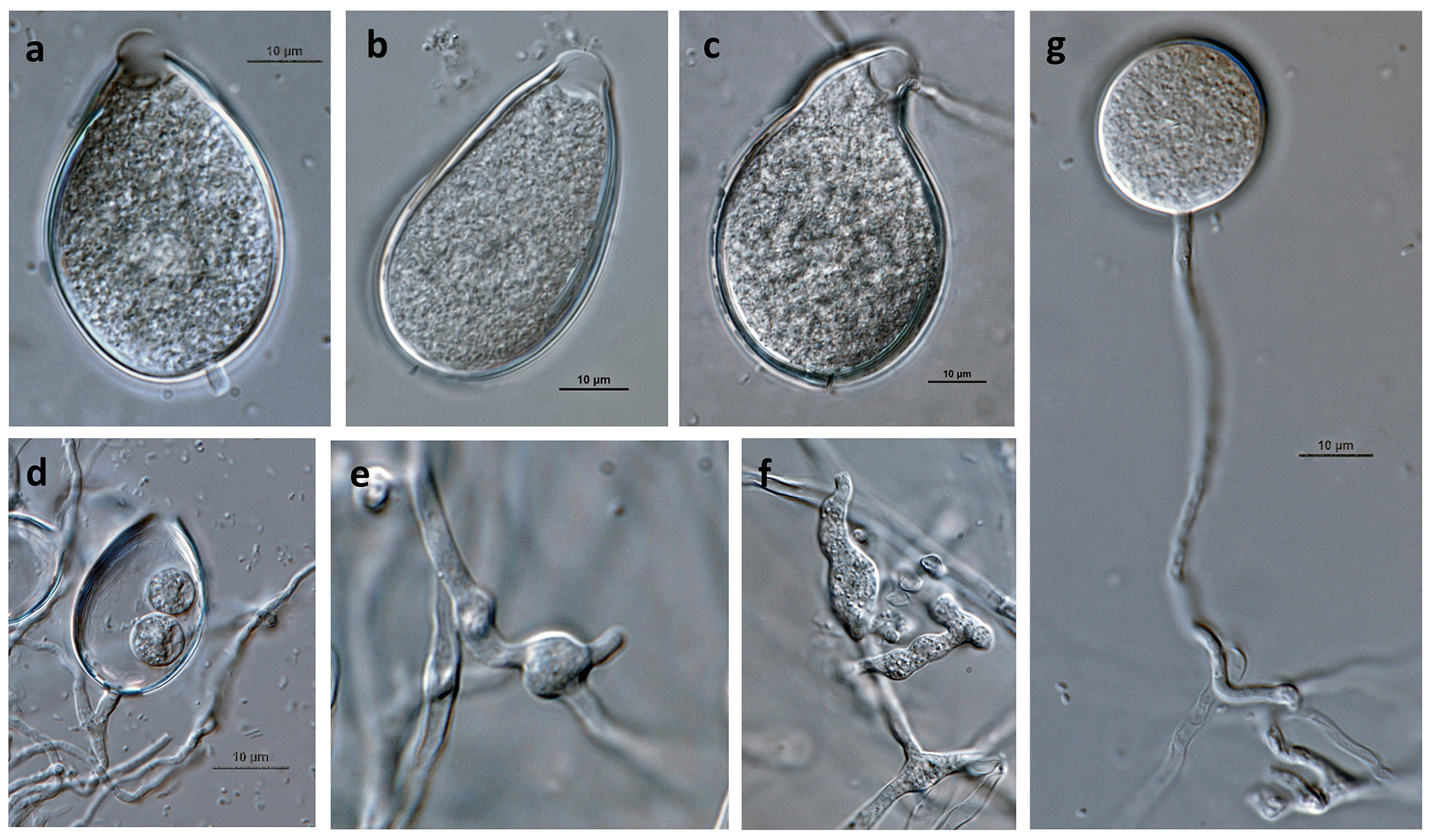

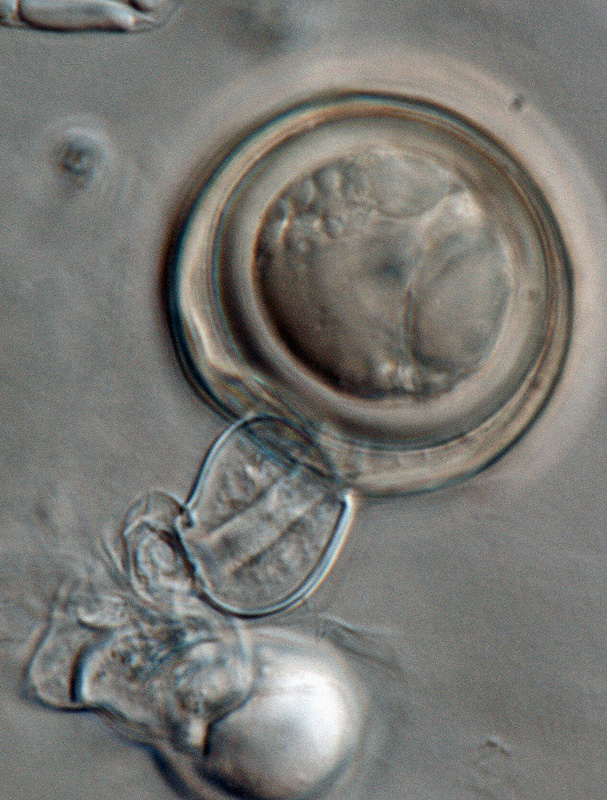
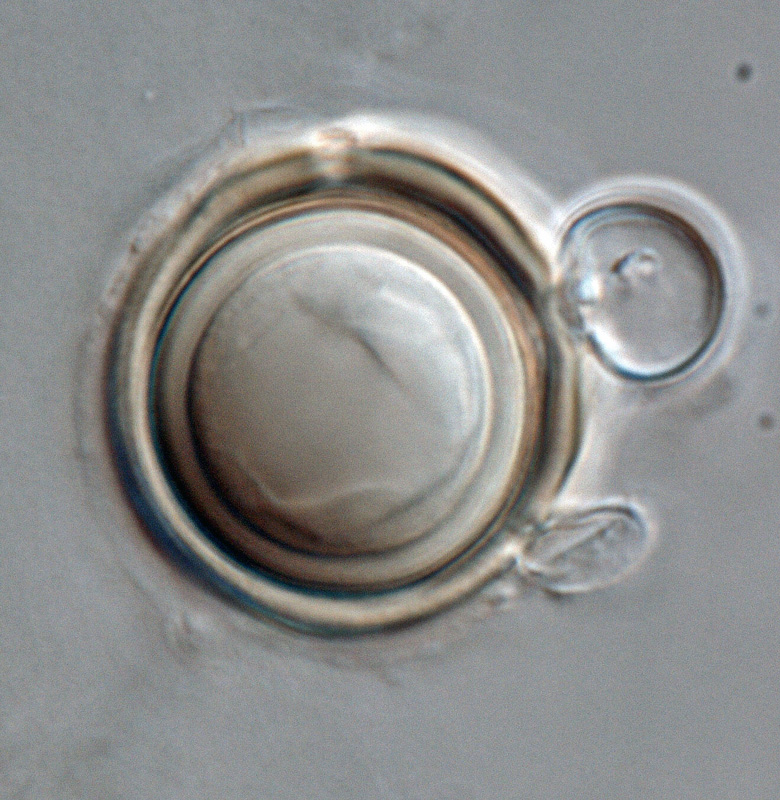
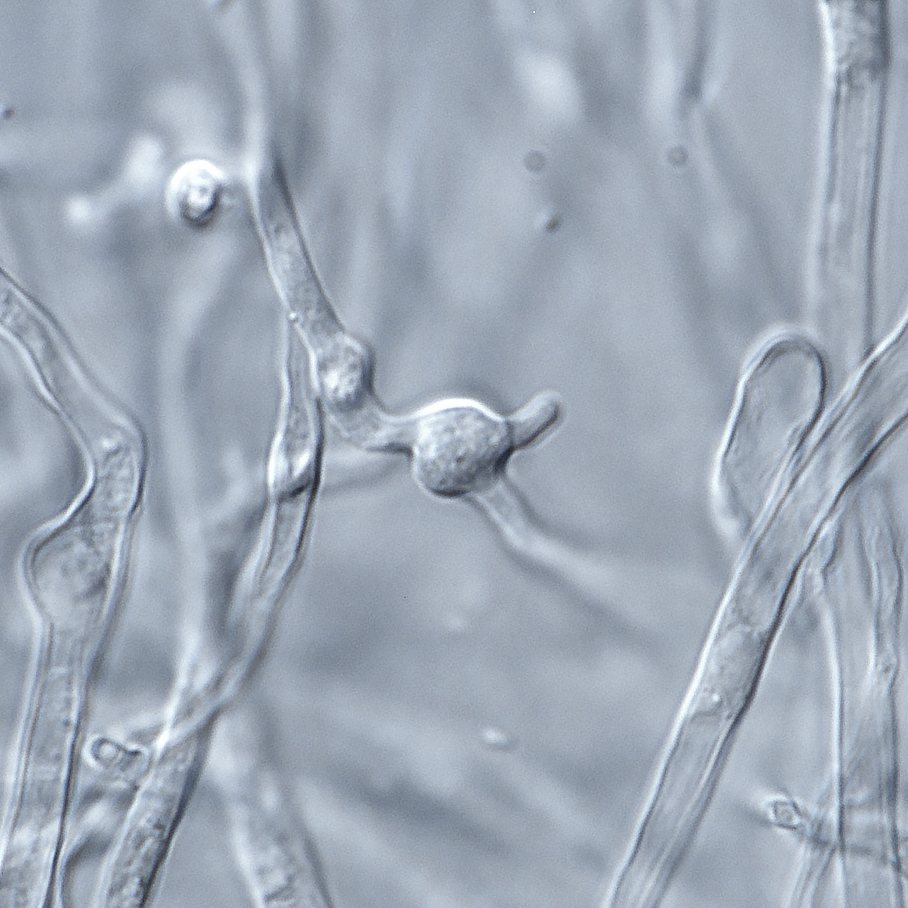
.jpg)
